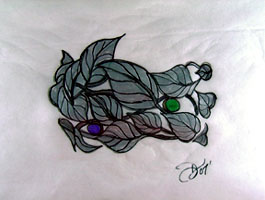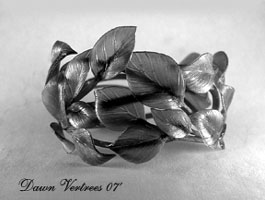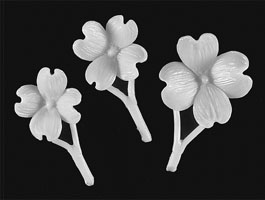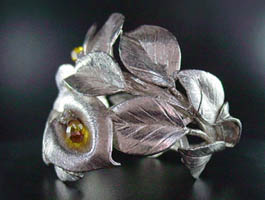- sale
- new items
- lovely beads
- wedding beads
- beads for teens
- for custom order
- newsletter
- recognition
- testimonials
- birthstones
- zodiac signs
- jewelry guide
SHOP BAG
![]() in your bag 0 items
in your bag 0 items

Because I started out as a porcelain artist I treat wax a bit different than what is taught by most jewelers. In most cases, Jewelry such as a pendant, ring, etc... also known as the "model" is carved out of a hard piece of wax. I on the other hand I enjoy modeling the wax by hand. I use a softer wax, in the form of sheets and pre-formed wires, which allows me to sculpt similarly to the way I used to sculpt porcelain. It just feels more comfortable in my hands. I use several tools, including many of my porcelain tools and some ordinary items such as an exacto knife, large needles, and small metal brushes or basically anything that will scrape, carve & cut.
Most of my work starts with a design based on conversations between my customer and I. They may have a favorite flower or just like the natural leaf design that is featured in my pieces. But mostly, they will see something I've already created and want a piece of jewelry they can call all their own. Although I have created several Limited Editions I enjoy designing one-of-a-kind pieces such as the bracelet shown.
Once we have established the design, then I will go over some of the stones I have in mind to go into the piece. I like working with pearls, precious gems such as emeralds, rubies as well as topaz, sapphires, tanzanite, etc. We will also discuss metals such as silver, 14K or 18k. It can be all silver or I can create a piece with a combination of silver and gold together.

Once the design is finished and most of the questions have been answered... I start on the wax model. This can take anywhere from a few days to several weeks. I try to keep the customer up on the progress so I maintain a blog on the Internet and continuously add updates to each featured piece.
In this particular piece the client wanted a heavier piece of jewelry, and at least 3" wide. I left open areas between the leaves and stems to set the stones we've picked out. It's one of the more complicated designs I've done so far but requires the same processes used to cast the simplest designs.
I'll try to take you through the casting process one step at a time. The process I use is called the Lost Wax Process. There are so many ways to create jewelry but this process allows me to create very organic shapes in soft materials that are easily sculpted, then convert these natural shapes into finished jewelry that is solid and strong and will last a lifetime, yet still have the delicate and natural shapes I started out to create. I wanted the soft curls in my leaves as if I was sculpting with my porcelain, but with the strength of cast silver.

As you've seen at the beginning of this article, I start with a wax model. I have a sample of three Dogwood Flowers showing the wax rods attached called a Sprue. The wax model is now mounted onto a base and fitted with a watertight section of pipe called a Flask. As a simplified illustration, picture a drinking glass (flask) with the wax model suspended and centered in the opening. The wax model is held in place by a cap that fits over the mouth of the glass and grips the wax model sprue to hold it in the center of the glass.
Next a plaster-like material called Investment is mixed to a creamy consistency. To remove any air bubbles in the mixture I place the mixing bowl under a special acrylic dome that fits tightly to the bench top. I apply vacuum to this dome for a few minutes and watch as the mixture "burps". The smooth de-aired investment is gently poured over the model as it stands in the center of the flask. Then the flask is placed in an oven where the flask is heated to burn the wax out of the investment (plaster), and to assist the investment plaster in curing completely. Once the wax is burned out it leaves a cavity exactly the shape of the original wax model! While the mold is still warm from the burnout, molten metal (sterling silver in this case) is forced into the mold where it assumes the shape of the original wax model. The silver is forced into every little cavity of the investment plaster by means of centrifugal force on a machine that actually spins the flask while the molten silver flows through the sprue area and into the mold. Once filled, the flask is allowed to cool for a brief period, and then rinsed in water. This causes the investment plaster to crumble and the new silver part is removed from the now broken mold.
If you ever worked with ceramic molds, it's a lot like this but instead of slip, your adding hot metals into the void. The biggest difference is the "mold" is destroyed at the end of this process instead of being used over and over again as it would be with ceramics.
Once the piece is cast, the cleaning process starts as well as setting the stones. This process can be very tedious and requires the use of a high speed "dremel" grinder as well as many files and burrs to remove any "flashing" left from the casting process. Sometimes my designs require multiple pieces and it's at this point that the separate pieces are assembled and soldered into place.
Settings are placed and finishing work is accomplished. This is the most rewarding part of the entire operation as I can finally see each piece come together as it was originally envisioned!
If you would like to see additional designs that I'm in the process of casting, please visit my blog, if you have any questions, please email me.
My gallery on MyLovelyBeads.com
About author:
| Dawn Vertrees, Fort Lauderdale, Florida, USA | |
| Email address: | dawnvertrees@bellsouth.net |
| Ruby Lane shop: | Dawn Vertrees at Ruby Lane |
| Blog: | www.dawnvertrees.blogspot.com |


